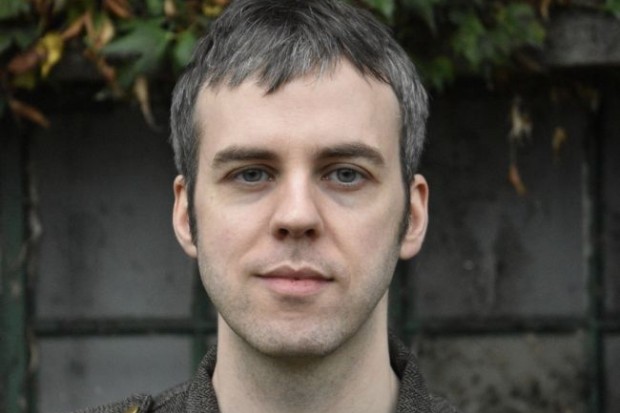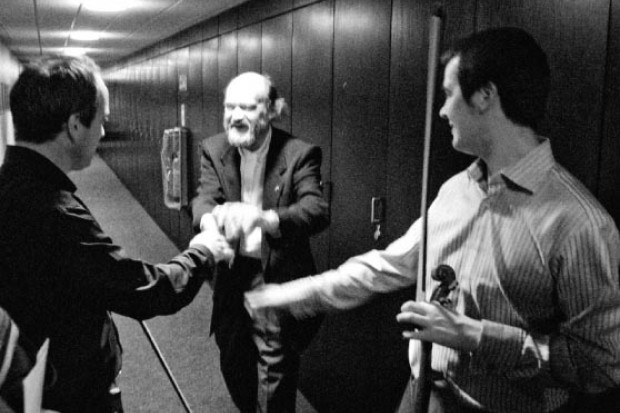
Eamonn Quinn (third from left) of Louth Contemporary Music Society with composer Sofia Gubaidulina, cellist Ivan Monighetti and double-bassist Malachy Robinson.
This is Curatorship
In 2009, the Louth Contemporary Music Society record label released its first album, A Place Between. Each track was distinct, with its own composer, soundworld, luminensce, and it unquestionably made an impression on me. But the album also had its own unified form: an unmistakable path leading deep into the Arctic quietude of Henryk Górecki’s Good Night, and emerging into John Cage’s In a Landscape.
In Search of the Miraculous, released some four years later, is not dissimilar in its blending of discrete elements to form a whole. A brooding groove for strings by the Lebanese Rabih Abou-Khalil sits beside a koan for solo piano by Armenian-American Alan Hovhaness; a deliberate, dancing guitar duo by Turkish composer Fazil Say is juxtaposed against a piano miniature by Siobhán Cleary, evoking both the English Baroque and 1960s New York jazz.
Overall, the individual tracks on In Search of the Miraculous spoke to me much less than those on A Place Between. But somehow, I found the album no less attractive, and no less a statement in itself. A huge part of this, I’m convinced, has to do with the performers: pianists Michael McHale and Elisaveta Blumina, violinist Ioana Petcu-Colan, soprano Patricia Rozario, Callino Quartet, Hilliard Ensemble; I could go on.
But neither album is about a single performer or ensemble. The ‘casting’ of these albums is part of a larger process, a process of working out, intuiting even, the placement of elements in relation to each other. This is curatorship. And when it works, I think you are interested regardless of whether you are interested in the individual elements by themselves.
Eamonn Quinn is the curator behind Louth Contemporary Music Society. Both a concert promoter and record label, LCMS was founded in 2006 by Quinn, who is from Armagh, is a guitarist and works by day with Louth and Meath Education and Training Board, and his wife Gemma Murray, who studied music at Queen’s, with the stated aim of bringing ‘world renowned contemporary musicians, performers and composers to play and educate in County Louth, Ireland’. Quinn, however, prefers to put the emphasis very much on the music itself and not on his role in the equation. He doesn’t introduce LCMS concerts; rather he prefers to let the music speak for itself. ‘I know I pick the music,’ he tells me, ‘but sometimes I feel the music picks me.’ His responses to my questions about his process are refreshingly forthright:
In relation to curating programmes, sometimes I don’t know why something appeals. It is almost an intuitive thing. I can feel it, that this piece of music will work either in a performance or a recording. It doesn’t matter to me who the composer is, the instrumentation or the context … but, simply, is the music any good?
Quinn’s responses speak to curation as a process that is as private, nebulous and intuitive as the creative process itself – a process all about allowing a ‘picture of the possible’ to take shape, a process of feeling out a new form.
Traditional topoi
The title of Ó Riada Re-Imagined, also released in 2013, is then particularly apt. For this project, Quinn commissioned the Uzbek composer Dmitri Yanov-Yanovsky to make a brand new arrangement of Seán Ó Riada’s 1968 Mass (Ceol an Aifrinn). The original work was written in a straightforward homophonic style – melody line with simple chordal accompaniement. Ó Riada was a champion of the integration of Irish traditional music into Western classical models, and so the melodic language is laced with traditional topoi. Yanov-Yanovsky allows these single-line themes to proliferate into a polyphonic fabric through skilful handling of a supple professional mixed chamber choir; the traditional Irish musical elements are further amplified through use of three traditional Irish instruments.
Again, the musicians on the recording are outstanding: the EQ Singers conducted by Eamonn Dougan, featuring handpicked singers from professional choirs like Chamber Choir Ireland and Resurgam, harpist Siobhán Armstrong, Zoë Conway on fiddle, and Robbie Harris on bodhrán.
The whole prospect has a palimpsestic quality that I found immediately interesting. The actual music on the disc failed to engage me at all – despite Yanov-Yanovsky’s obvious skill in handling the material in question, and the nuanced performances, it seemed somehow restricted, unable to find clarity of purpose, clarity of focus. But nevertheless, I feel that the occasion of the album (the curatorial premise) possesses a special invitational quality – perhaps the same kind of invitational quality that some of us feel just looking at the cover art of a release on the ECM label (before we’ve even heard the music)?
The most recent LCMS release, Song of Songs (2015), however, had me rapt from the first moments. Its opener, David Lang’s Just (after The Song of Songs), another in an impressive list of LCMS commissions that features work by composers such as Terry Riley, Arvo Pärt and John Zorn, is Lang at his best – limpid in harmony, iconic in gesture, careful in pacing. And lyrically striking – the three beautifully matched female voices of Trio Mediaeval intone a list of possessions gleaned from the Biblical Song of Songs, each prefixed by formulas such as ‘just your…’ or ‘and my…’. A finely balanced instrumental trio of violist Garth Knox, cellist Agnès Vesterman and percussionist Sylvain Lemêtre supplies just the right amount of punctuation and counterpoint – bass drum strokes, snatches of plucked cello, a plaintive viola descant – the effect is mesmeric.
Hear the potential
In response to questions about profoundness and experience, Quinn tells me that he adores the visual art of Agnes Martin. ‘I really like the fact that her aesthetic – her subject – was feeling,’ he says. ‘Yet feeling anonymous and unadorned.’ And this is exactly how the LCMS recording of David Lang’s Just (after The Song of Songs) comes across to me. The piece feels at once personal and emotional, intimate even, and coolly abstract, unsentimental. It’s a difficult intersection to master. (And as an aside, I might add that the track’s use in the teaser for the film La Giovinezza by Paolo Sorrentino, where the cuts dialogue gracefully with the musical grammar, creates (for me) a uniquely cinematic impression of the same phenomena.)
Song of Songs as an album is, again, a triumph of curation. Its tripartite form is completed by Luciano Berio’s nearly twenty-minute Naturale (performed by a Knox / Lemêtre duo with soundtrack) and Betty Olivero’s En la mar hai una torre, where Trio Mediaeval, Knox, Lemêtre and Vesterman are joined by harpist Clíona Doris. The consistent instrumental/vocal colours unify the record for sure, but there are also charged material tensions between the three tracks. I find it hard to imagine any piece by Luciano Berio, of the Darmstadt generation, that might compliment a piece by New York co-founder of Bang on a Can, David Lang – or vice versa. Yet Berio’s Naturale, with its fixed soundtrack element featuring hair-raising recordings of a Silician folk-singer, and its yearningly expressive viola contours, somehow sparks off the Lang – an intense tangent, but we can clearly hear the points of connection in the unaffected folk-esque undercurrents of both works.
Naturale might be the only Berio piece that could have this kind of complimentary relationship with a Lang work – but I’m all the more impressed with the curatorial sensibility that can hear this, or, since Lang was actually a new commission, the sensibility to hear the potential. En la mar hai una torre by Berio’s student, Betty Olivero, then mediates between the two worlds; declamatory vocalisations are cooled by gently prosaic harp material.
One does notice a prevalence of religious themes in the output of LCMS. For example, another 2013 release, Monk’s Music, is the world premiere of Alexander Raskatov Seven Words by Starets Silouan, for string quartet and bass voice. Consciously modelled on Joseph Haydn’s The Seven Last Words of Christ, Raskatov’s work sets material from the religious writings of Starets Silouan (1866-1938), a Russian monk. It seems that such religious or Biblical themes recur often enough with LCMS to warrant asking Quinn if religion is perhaps a shaping factor or at least a factor in play. He says no, his focus is purely musical: ‘I wouldn’t programme a piece of music simply because of its title or subject matter.’ He continues: ‘I’m talking solely about music, nothing else. The power in a performance that can make the hairs stand on the back of your neck so you think “Oh wow, that was amazing”.’ He quotes Edmund Jabès: ‘Through the ear, we shall enter the invisibility of things’.
I will always look towards LCMS recordings for the promise of this elusive experience – this religious experience transcendent of any religious dogma that I want from all art – even if I don’t always find it.
–
Louth Contemporary Music Society’s next concert is a performance of Michael Pisaro’s asleep, forest, melody, path on Saturday 17 October at the Oriel Centre at Dundalk Gaol. Visit www.louthcms.org.
Published on 16 September 2015
Garrett Sholdice is a composer and a director of the record label and music production company Ergodos.

















